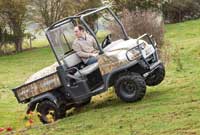Buggy Test: Kubota RTV 900

First impressions:
The most workmanlike looking of the lot, with a robust roll bar, bull-bars and a useful grille at the back to stop loads sliding forward.
Overall build quality is good inside and out, although the gearstick seemed a little flimsy.
Chassis and suspension
Like most of the other buggies on test, the RTV900 uses a step-frame chassis with the engine and transmission carried in a separate cradle under the load deck.
Up front, independent springing comes in the form of a single-wishbone/coil-spring and damper set-up. At the rear there’s a rigid tubular axle carried on leaf springs with shock absorbers.
Engine and transmission
A beefy aluminium powertrain gives away Kubota’s compact tractor heritage. The 21hp, three-cylinder, 898cc engine and three-range hydrostatic transmission come straight from the Japanese firm’s groundscare product range. In fact it was the only hydro CVT on test.
Driveability:
The high driving position is a bonus and the layout makes it feel like a proper work vehicle.
It’s the only vehicle to have three speed ranges, although we reckon it could manage OK with two. Because it’s hydrostatic, Kubota had to fit a pressure-release system (handled by a dash-mounted knob) to help the lever engage the gears smoothly. It’s a bit of a works and the knob would be better on the floor or on the gear stick itself.
A good point was that it was also only one of only two machines to have powered steering, which was positive and not too light. However there’s some power loss (due to the hydrostatic transmission) and the hill climb needed to be tackled in medium range.
Watch the Kubota RTV 900 in action
Braking
Oil-immersed discs are mounted front and rear. Engine braking was the best on test by a long way. However, take your foot off the throttle completely and you come to a very abrupt, crash-test-dummy-style stop.
Practicality and servicing
The high air intake is great for wading but the battery could do with more protection from the wet.
Cab:
Bench seats up front mean there’s loads of space for passengers, but that means it’s technically not legal for road use. Gearstick and controls are easy to get to and well laid out. The dash was the best on test, with a speedometer and fuel plus oil gauges.
Pros: Hydrostatic downhill engine-braking Robust build – compact tractor heritage Enclosed, oil-immersed disc brakes Cons: Power loss through transmission Need for pressure release valve Meagre storage |
|---|
To see results from the other buggies click on the link below:
Kawasaki Mule 4010 Trans 4×4 – best all-rounder
Massey Ferguson 20 MD – best handling at speed
JCB Groundhog 4×4 – best load independent suspension
And for more pictures from the tests click here.

